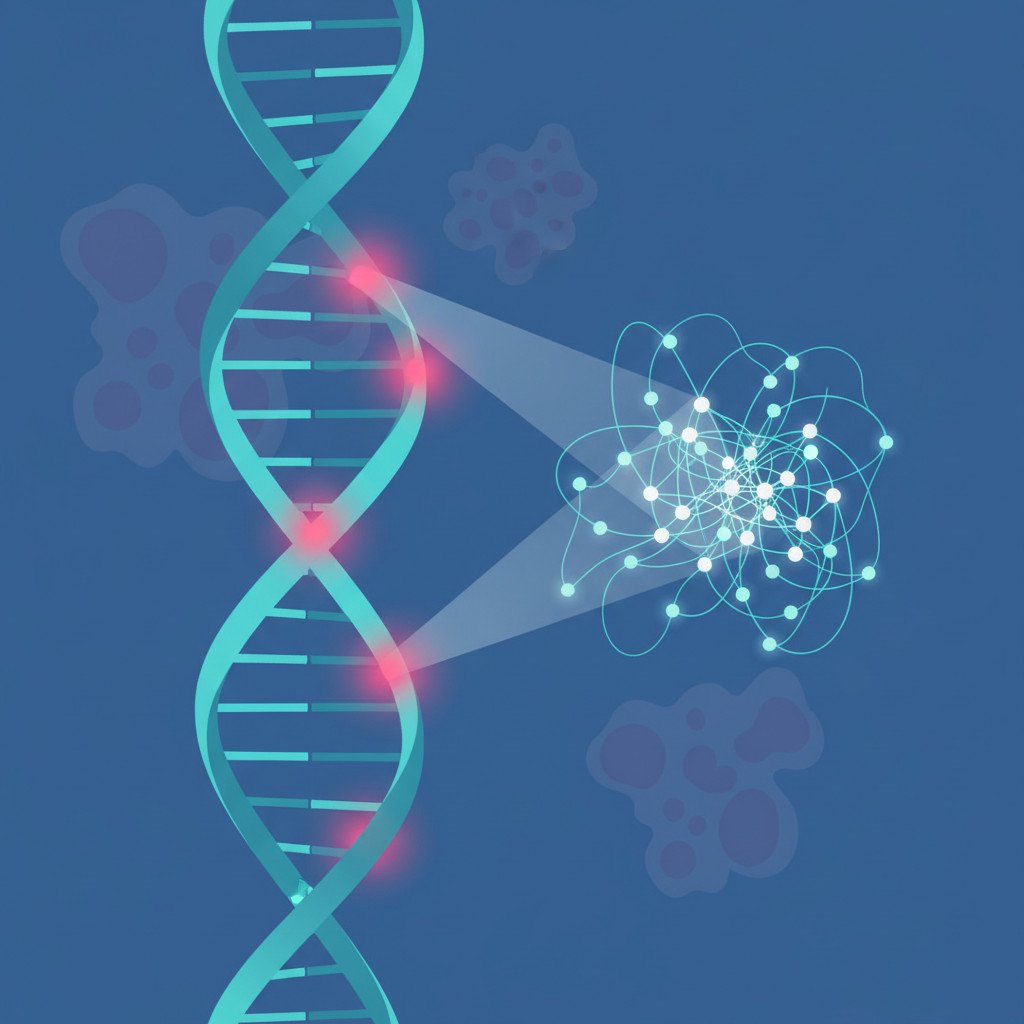Introduction
DeepSomatic: AI tool for identifying somatic cancer mutations promises faster, more accurate detection of tumor-only variants. Because accurate mutation calls guide targeted therapy, this advance matters for patients. Using convolutional neural networks, DeepSomatic spots somatic variants that other methods miss. Therefore it can operate in tumour-only mode when normal samples are missing.
In this article we explain how DeepSomatic improves variant calling across sequencing platforms, including Illumina and Pacific Biosciences. We also cover tests on FFPE and whole exome sequencing, and results on glioblastoma and paediatric leukaemia. As a result, researchers and clinicians can better pursue precision medicine options. Read on to learn key findings, limitations, and how to access the openly available tool and CASTLE dataset.
Moreover, the work appears in Nature Biotechnology, which signals strong peer reviewed validation. It outperformed leading methods on Illumina and Pacific Biosciences sequencing data, sometimes by large margins. Therefore clinicians and researchers may get clearer variant calls to inform treatment and trials.
DeepSomatic: AI tool for identifying somatic cancer mutations — what it does
DeepSomatic: AI tool for identifying somatic cancer mutations uses convolutional neural networks to detect tumour-specific variants. Because it focuses on somatic cancer mutations, it separates inherited germline changes from tumour-only signals. This approach powers machine learning in cancer detection and advances AI in oncology research.
The model converts sequencing reads into image-like inputs and learns variant patterns. It runs in tumour-only mode when matched normal samples are unavailable. Also, it supports multiple sequencing platforms, including short-read and long-read technologies. Therefore labs can apply it to Illumina and Pacific Biosciences data with consistent results.
Core features and benefits
- High accuracy for small variants and indels across platforms
- Tumour-only mode for samples lacking matched normal tissue
- Trained with convolutional neural networks for nuanced pattern detection
- Robust to FFPE artifacts and whole exome sequencing noise
- Openly available code and benchmarks for reproducible research
Why DeepSomatic stands out
DeepSomatic outperformed other callers on benchmark tests, achieving higher F1-scores on Illumina and PacBio. Moreover, the team released the CASTLE benchmark dataset to support validation. You can read the Google research write-up at Google research write-up and access the CASTLE data at CASTLE data. For additional context and analysis, see the feature on Articles. As a result, the tool boosts precision medicine efforts and helps clinicians find clinically relevant variants faster.

Evidence and case studies: DeepSomatic: AI tool for identifying somatic cancer mutations
Published in Nature Biotechnology, DeepSomatic showed measurable gains in benchmark tests. Because peer review validated the work, the results carry weight. The Nature article is available at Nature Biotechnology.
Key performance highlights
- On Illumina sequencing data DeepSomatic reached a 90% F1-score. The next best method scored about 80%.
- On Pacific Biosciences long-read data DeepSomatic scored over 80% F1. By contrast, the next best tool scored under 50%.
- It outperformed competitors on formalin fixed paraffin embedded samples and on whole exome sequencing.
- In a glioblastoma sample the model pinpointed the few known driver variants. Therefore it showed clinical relevance for aggressive cancers.
- In a collaboration with Children’s Mercy Kansas City the tool analysed paediatric leukaemia samples. It confirmed known variants and discovered 10 new candidate variants.
Benchmarking and open resources
Google Research published a detailed summary and methods on their blog at Google Research Blog. Moreover, the team released the CASTLE benchmark dataset to support reproducible testing. You can access CASTLE at CASTLE Dataset.
What this evidence means
The combined results show DeepSomatic can detect somatic variants across technologies. As a result, researchers can trust more complete variant calls. Furthermore, open data and code accelerate independent validation and clinical translation.
Comparison of DeepSomatic and Popular Somatic Callers
Below is a brief comparison of DeepSomatic and popular somatic callers. Because accuracy depends on sequencing platform, the table notes Illumina and PacBio performance. However, real-world speed depends on hardware and pipeline.
| Tool | Features | Accuracy (CASTLE benchmark / platform notes) | Speed | Ease of Use | Cost |
|---|---|---|---|---|---|
| DeepSomatic | Convolutional neural network; tumour-only mode; multi-platform support; robust to FFPE; open CASTLE dataset | Illumina F1 ~90%; Pacific Biosciences F1 >80% | Moderate; benefits from GPU acceleration | Open-source CLI; model download required | Free open-source; compute costs apply |
| Mutect2 (GATK) | Bayesian somatic caller; tumour-normal support; integrates with GATK pipelines | Illumina ~80% (next-best in CASTLE); PacBio performance lower | Fast on CPU; scales with cluster | Widely used; moderate setup due to GATK preprocessing | Free; compute costs apply |
| Strelka2 | Sensitive small variant caller; supports tumour-only and tumour-normal modes | High on short reads; lower on long reads (PacBio <50%) | Very fast for targeted and exome data | Easy to integrate; clear documentation | Free; compute costs apply |
| VarScan2 | Heuristic somatic caller; works with low coverage; simple filters | Good for noisy or low-coverage data; lower accuracy than DeepSomatic on CASTLE | Fast | Simple CLI; requires tuning for best results | Free; compute costs apply |
Notes
- Accuracy values come from CASTLE benchmark observations and Google Research results. Therefore, numbers vary by sample type and coverage.
- Choose a tool based on platform, sample type, and clinical needs. For tumour-only or long-read data, DeepSomatic showed clear advantages.
Conclusion
DeepSomatic delivers a clear advance in detecting somatic cancer mutations. Because it uses convolutional neural networks, it improves accuracy across Illumina and Pacific Biosciences platforms. It also supports tumour-only mode when matched normal samples are unavailable. As a result, clinicians and researchers obtain clearer variant calls to guide precision medicine decisions.
The work appeared in Nature Biotechnology and the team released the CASTLE benchmark to enable reproducible testing. In case studies, DeepSomatic pinpointed driver variants in glioblastoma and found new candidates in paediatric leukaemia. Therefore the tool shows both research and clinical promise, especially for long-read and FFPE samples.
EMP0 supports organisations that adopt AI for business automation and healthcare innovation. Visit EMP0 to learn about their AI services and consulting. For workflow automation resources, see n8n for creators. Consider how AI in oncology can speed discovery, improve diagnostics, and help scale smarter clinical workflows.
Frequently Asked Questions (FAQs)
What is DeepSomatic and how does it work?
DeepSomatic: AI tool for identifying somatic cancer mutations uses convolutional neural networks to scan sequencing reads and call tumour-specific variants. Because it converts reads into image-like inputs, the model learns complex error and signal patterns. It separates somatic cancer mutations from germline variants. As a result, it improves machine learning in cancer detection and advances AI in oncology workflows.
How accurate is DeepSomatic compared with other callers?
DeepSomatic showed strong benchmark performance. On Illumina data it reached about a 90% F1-score, versus roughly 80% for the next-best method. On Pacific Biosciences long-read data it scored over 80% F1, while alternatives scored under 50%. Therefore for long-read and tumour-only scenarios, DeepSomatic offers clear accuracy benefits. However results vary by sample type, coverage, and preprocessing.
Can DeepSomatic run without a matched normal sample?
Yes. DeepSomatic supports tumour-only mode when matched normal tissue is unavailable. This makes it useful for clinical or archival FFPE samples. In addition, it remains robust to FFPE artifacts and whole exome sequencing noise. As a result, labs can call somatic variants even when normal controls are missing.
Is DeepSomatic ready for clinical use and what are the limits?
DeepSomatic is promising and peer reviewed in Nature Biotechnology, which supports its validity. Still, clinical adoption requires local validation and regulatory review. Therefore clinicians should confirm calls with orthogonal tests and established pipelines. The tool aids precision medicine by flagging candidate driver variants, yet it should complement clinical judgement.
Where can researchers access DeepSomatic and supporting data?
The DeepSomatic model and the CASTLE benchmark are openly available. For methods and a project overview, see the Google Research blog. For benchmark data, access CASTLE at Zenodo. These resources help reproducible research and independent validation.

